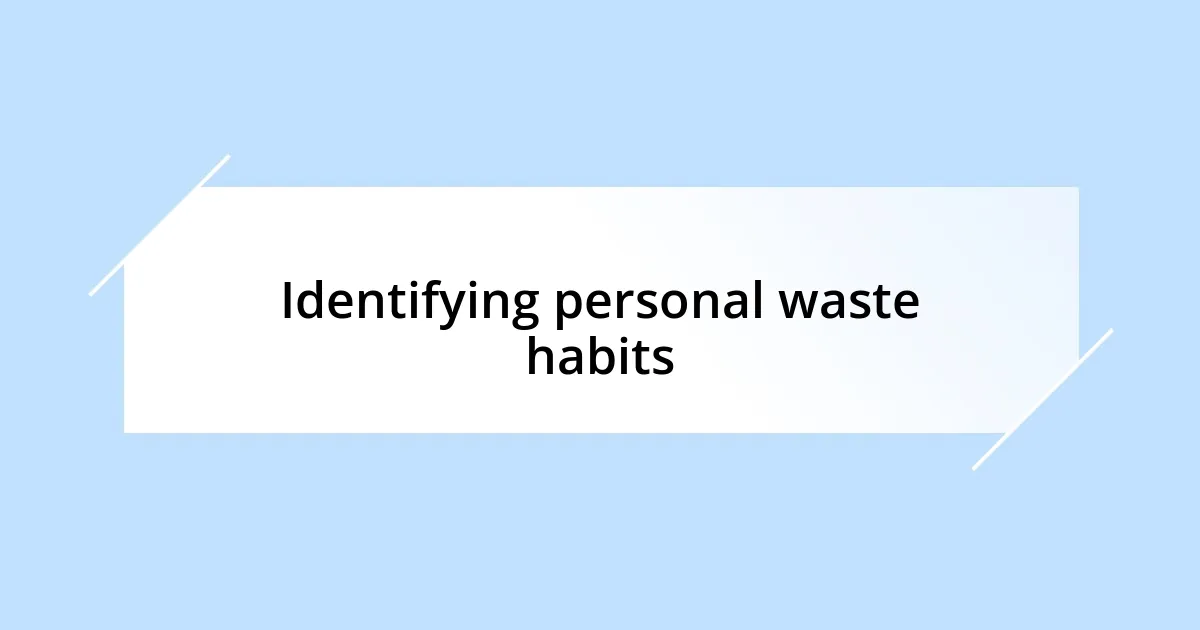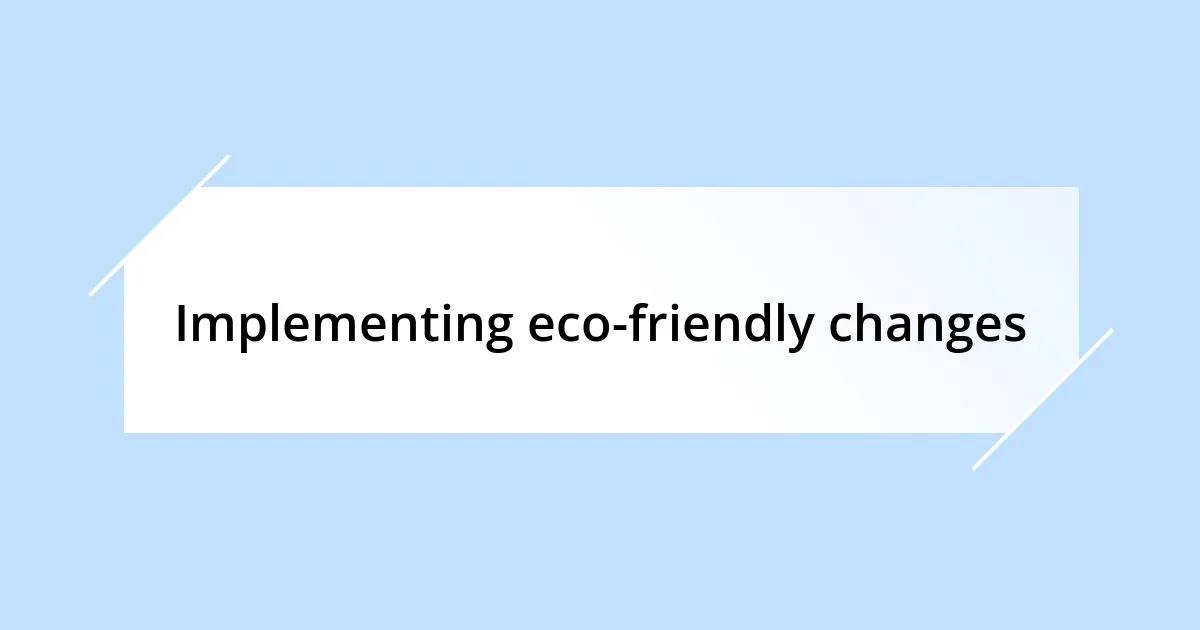Key takeaways:
- Embracing eco-conscious habits involves critical self-reflection on consumption and waste management, fostering a sense of fulfillment through sustainable choices.
- Researching sustainable practices, such as local sourcing and composting, enhances understanding and commitment towards eco-friendly living.
- Supporting local businesses connects consumers with sustainable practices and encourages intentional purchasing habits, reshaping identity and values.
- Tracking progress through journaling highlights areas for improvement and reinforces motivation, while adjustments to strategies foster personal growth and adaptability.

Understanding eco-conscious living
Eco-conscious living is much more than just a trend; it feels like a fundamental shift in how we relate to our planet. When I first started this journey, I remember standing in my kitchen, overwhelmed by the amount of plastic waste I was producing. It made me wonder: how can something so convenient feel so wrong?
Embracing eco-conscious habits has taught me to think critically about my consumption. I often ask myself, “Do I really need this?” This simple question has shifted my perspective. Rather than automatically reaching for new products, I began to seek out alternatives—whether it’s repurposing items I already own or choosing second-hand options. This not only reduces waste but brings a sense of fulfillment that new items simply can’t offer.
I’ve found that eco-conscious living encourages a deeper connection with my community and the environment. Volunteering for local clean-up initiatives opened my eyes to how much we can accomplish together. It’s a powerful reminder that each of us has a role to play in creating a healthier planet, and that sense of shared purpose is incredibly motivating. Isn’t it inspiring to think about the impact we can have when we make mindful choices together?

Identifying personal waste habits
Recognizing my own waste habits was an eye-opening experience. I remember sorting through my trash one day, and it struck me how much of it was avoidable. It felt disheartening to see all those plastic bottles and wrappers, items I could have easily replaced with more sustainable choices. It was this moment that fueled my desire to make changes.
To start identifying personal waste habits, I began to closely observe my daily routine. Here’s what I discovered:
- Packaging Waste: I noticed a significant amount of waste came from single-use packaging, like food containers and grocery bags.
- Food Waste: After tracking my meals, I realized a lot of good food went uneaten, leading to unnecessary waste.
- Shopping Patterns: I found myself mindlessly buying items I didn’t need, often just because they were on sale.
This process helped me narrow down areas where I could make a real difference, and believe me, it felt empowering to take action.

Researching sustainable practices
As I delved into researching sustainable practices, I found a wealth of information that both inspired and motivated me. Initially, I felt overwhelmed by the sheer volume of resources available, from books to documentaries to articles. However, I quickly learned to navigate through this information. I focused on credible sources and practical examples that I could integrate into my daily life. For instance, I discovered that something as simple as cooking with local, seasonal ingredients can significantly reduce my carbon footprint.
One standout moment for me was watching a documentary on sustainable farming practices. It opened my eyes to the impact agriculture has on our environment. I used to think that organic produce was a luxury, but I realized it’s actually an investment in our future. Understanding that farmers who employ these practices contribute to biodiversity and soil health made me feel more connected to what’s on my plate. This critical knowledge reshaped my shopping habits, prioritizing local vendors over large supermarkets.
Throughout my research, I started jotting down notes on various initiatives that resonated with me. I created a comparison chart to visualize different sustainable practices, helping me make informed choices. This hands-on approach not only clarified my thoughts but also fueled my commitment to live more sustainably. I find it exciting to continually discover new practices that align with my eco-conscious goals.
| Sustainable Practice | Impact |
|---|---|
| Local Sourcing | Reduces transportation emissions and supports local economies |
| Composting | Reduces waste in landfills and enriches soil |
| Zero-Waste Shopping | Minimizes packaging and promotes sustainable post-consumer use |

Implementing eco-friendly changes
Implementing eco-friendly changes can feel like a daunting task, yet I discovered that it doesn’t have to be overwhelming. When I first decided to reduce my plastic use, I started by switching to reusable bags and bottles. I even remember the moment I walked into my favorite café, proudly carrying my own cup instead of grabbing a disposable one. It was a small change, but the satisfaction it brought me was immense. Have you ever felt that rush of accomplishment when making a positive choice?
One effective strategy I adopted was gradually replacing everyday products with eco-friendly alternatives. Initially, I tackled cleaning supplies; after switching to biodegradable cleaners, I noticed not only a reduction in harsh chemicals lingering in my home but also smoother surfaces and fresher air. I marveled at how simple changes could create a healthier living environment. It made me question – what else had I overlooked that could positively impact both my life and the planet?
I also made a significant effort to embrace a plant-based diet, and this shift profoundly changed my relationship with food. The first time I cooked a hearty vegetable stir-fry, I felt a blend of excitement and curiosity about how flavors could come together without meat. By experimenting with vegetarian meals, I became more creative in the kitchen, exploring ingredients I had never tried before. Plus, knowing that I was contributing to lower greenhouse gas emissions made each bite even more enjoyable. Can you imagine how rewarding it feels to nourish both your body and the Earth?

Supporting local and sustainable businesses
Supporting local and sustainable businesses has truly become a cornerstone of my eco-conscious journey. I remember the thrill of visiting my town’s farmers’ market for the first time; it was like uncovering a treasure trove of fresh produce and artisanal goods. I felt a profound connection to the farmers working hard to bring their products to the community. By purchasing directly from them, I wasn’t just getting delicious food; I was also investing in sustainable practices and strengthening local economies. Have you ever stopped to think how empowering it is to support the very people who nurture our land?
One unexpected joy I discovered was how shopping locally allowed me to explore new flavors and products I never knew existed. Last week, I decided to try out a new eco-friendly pottery shop that just opened nearby. As I browsed handcrafted mugs and plates, I was struck by the creativity and passion behind each piece. Every item told a story, and I felt like I was bringing a part of that artistry into my home. This experience made me realize how much richer life can be when I prioritize local artisans over mass-produced items. Have you ever felt that rush of excitement when you find something unique that perfectly reflects your values?
Moreover, supporting sustainable businesses has influenced my perspective on consumerism. I noticed how often I used to grab things on impulse, without thinking about their origin. But now, every purchase feels more intentional. Before I buy, I often ask myself questions like, “Where does this come from?” and “What impact will it have?” This shift has not only deepened my appreciation for what I consume but has profoundly shaped my identity. Learning to choose wisely makes me feel not just like a shopper but a participant in a larger, meaningful movement. Isn’t it invigorating to think that every dollar spent can be a vote for the values I believe in?

Tracking progress and making adjustments
Tracking my progress on the eco-conscious path has been quite revealing. I decided to keep a journal, noting each switch I made, from using beeswax wraps instead of plastic to opting for second-hand clothing. Each entry not only served as a record but also as a motivational tool that reminded me of my commitment. Have you ever found that writing down goals can help solidify them in your mind?
As I reviewed my journal, I noticed patterns emerge, illuminating areas where I could further improve. For instance, I had gotten really good at reducing waste in my kitchen, yet my consumption of fast fashion kept creeping back in. This sort of self-reflection isn’t always easy; it can be a bit uncomfortable to recognize where I’ve fallen short. But isn’t discomfort often the first step toward genuine growth?
Adjusting my approach became essential as I learned what worked and what didn’t. When I tried a zero-waste grocery initiative, I quickly realized that taking my own jars for bulk items was more challenging than I anticipated. A few times, I found myself forgetting them entirely and feeling frustrated when I had to resort to pre-packaged items. So, I started setting reminders on my phone—an easy adjustment that transformed my shopping trips. Through these experiences, I’ve learned that tracking progress isn’t just about celebrating victories but also embracing the lessons learned along the way. How do you hold yourself accountable while on a similar journey?














